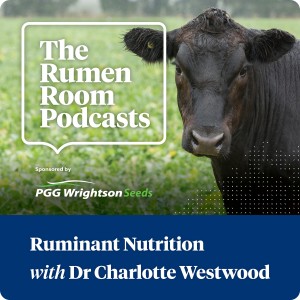
Friday Jan 19, 2024
43. Hot and bothered summer pastures – less dry matter and poorer nutritive value for your grazing ruminants
With the New Zealand summer in full flight during early 2024, it’s timely to review how hot temperatures potentially alter the dry matter yields and nutritive value of our temperate pasture species.
Exploring first how hot temperatures impact dry matter yields (kilograms of dry matter grown per hectare per day), the podcast looks at effects of hot weather on New Zealand’s most common pasture species combination, perennial ryegrass (Lolium perenne) and white clover (Trifolium repens). Other species discussed include continental (summer active) tall fescue (Festuca arundinacea) and cocksfoot (Dactylis glomerata, otherwise known as orchard grass) and red clover (Trifolium pratense).
Nutritive value of temperate pasture species, as influenced by hot temperatures is covered, looking specifically at digestibility and MJME, as well as NDF, NDFd and non-structural carbohydrates as influenced by hot temperatures.
A note that we make within this podcast is that the selection of pasture species should never be made simply on the basis of heat tolerance, in isolation from other factors to consider. Multiple factors also requiring consideration include soil fertility, pH, rainfall/irrigation, and paddock aspect - to name but a few factors other than heat tolerance. Talk with your local PGG Wrightson Seeds agronomy expert for all the information you need around your regrassing requirements.
Various sections within the podcast can be found below. Hope that you find this topic a "cool little topic" to tune into (pun totally intended). Happy listening!
0.55 Introduction
1.39 Overview of the content of our latest podcast
2.05 Scene set – Overview of New Zealand pastures (for the benefit of our non-New Zealand based listeners)
3.40 The wide range of pastures from the north to the south of New Zealand
6.35 Dry matter yield by pasture species when hot summer temperatures arrive (along with other factors including moisture deficit)
8.35 The “ideal” daytime temperatures that support optimum growth rates by our temperate C3 pasture species?
9.50 How hot is too hot for our temperate C3 pastures? Perennial ryegrass, continental tall fescues & cocksfoot
10.05 How hot does it need to be before perennial ryegrass gets hot and bothered?
10.40 Tolerance to temperature by tall fescue compared to perennial ryegrass
11.45 Adequate moisture allows C3 grasses to better tolerate hot temperatures.
14.10 Cocksfoot tolerance to hot temperatures and moisture stress/dry conditions compared to perennial ryegrass
15.50 The role for endophytes in perennial ryegrass and tall fescue and tolerance of heat
17.25 How frequent irrigation helps temperate grasses handle hot temperatures – “transpiration” and evaporative cooling
20.00 **Don’t select a temperate grass species ONLY on the basis of heat tolerance, there are so many other factors to consider when moving away from perennial ryegrass as you core grass species.**
22.30 Legume (clovers, lucerne) growth during hot weather
23.40 Chicory handling hot conditions – but only if adequate moisture is available
25.40 Nutritive value of temperate pasture during hot weather – changes to digestibility, MJME, NDF and NDFd
30.50 Digestibility and NDF changes by tall fescues and perennial ryegrass as summer temperatures increase
35.55 Legumes – changes in nutritive value with hot temperatures
39.50 Legume quality changes over summer – not related to grazing management and temperature
40.20 More clovers in pastures swards – the rumen bloat conundrum
42.35 Temperate grasses - Non-structural carbohydrates (water soluble carbohydrates and starch) changes with temperature
43.30 Temperate legumes - Non-structural carbohydrates changes with temperature
48.50 Recap / conclusion of topics covered
Comments (0)
To leave or reply to comments, please download free Podbean or
No Comments
To leave or reply to comments,
please download free Podbean App.